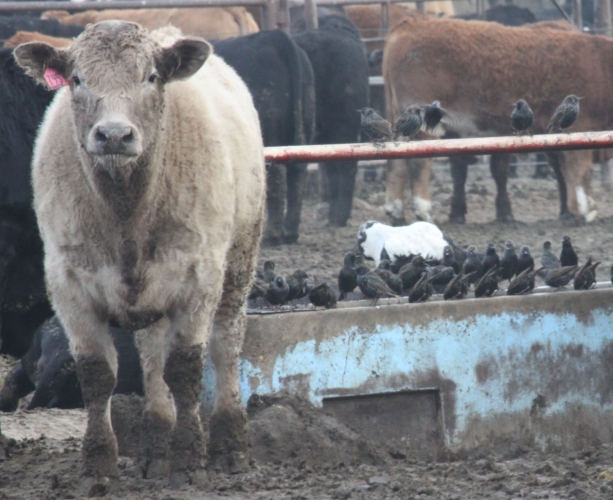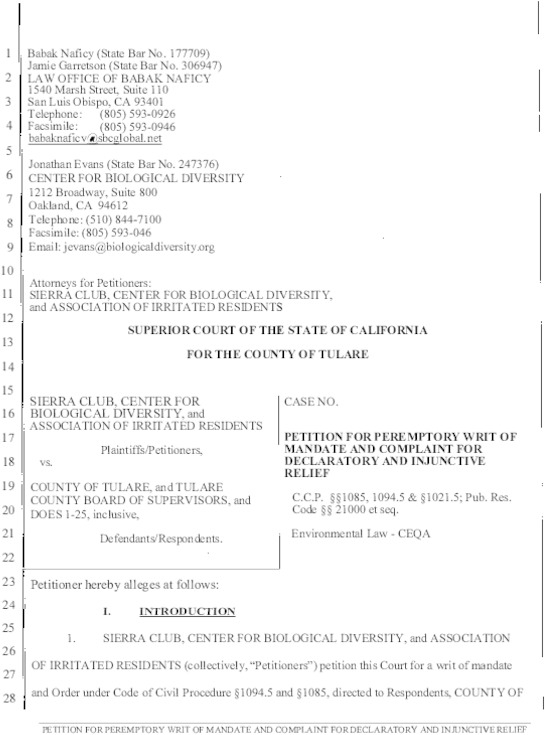From the Open-Publishing Calendar
From the Open-Publishing Newswire
Indybay Feature
Lawsuit Challenges Tulare County's Flawed Plan to Limit Harmful Greenhouse Pollution From Industrial Cattle Operations
VISALIA, Calif., January 11, 2018 — Conservation groups sued Tulare County today for approving a climate action plan for giant feedlots and other industrial cattle operations that would worsen air quality and undercut California’s greenhouse gas reduction goals.
Today’s lawsuit asks the court to set aside the county’s climate-action plan and animal-confinement facilities plan until officials identify steps to cut pollution from industrial dairies and feedlots and disclose the true environmental and financial costs of those emissions.
“I’ve seen firsthand how air pollution from industrial dairies leads to health problems like headaches in my own family. Tulare County must take stronger steps to protect people in the community,” said Tom Frantz, executive director of Association of Irritated Residents and an almond farmer in the San Joaquin Valley. “Six thousand animals in one dairy have the waste stream of a city of half a million people, and there are common sense ways to reduce the air pollution from dairies that the county overlooks.”
Tulare County is home to more than 1 million cattle — more than double the human population — and produces more milk than any other U.S. county.
Industrial cattle operations in the county produce the equivalent of 7.5 million metric tons of carbon dioxide per year — approximately 63 percent of the county’s greenhouse gas emissions in 2013. By 2023 that number is expected to grow to the equivalent of almost 9 million metric tons of carbon dioxide per year.
Industrial dairy and feedlot operations also produce hazardous air pollutants such as ammonia and particulate matter.
“Tulare County has to stop ignoring the unhealthy reality that dairies and feedlots release nearly two-thirds of the county’s greenhouse pollution,” said Hannah Connor, a senior attorney at the Center for Biological Diversity. “Instead of protecting public health, county officials are sabotaging efforts to curb climate change’s devastating effects.”
The groups note that the county’s so-called Dairy and Feedlot Climate Action Plan and Animal Confinement Facilities Plan undermine California’s greenhouse gas reduction goals. For example, they allow cattle operations to avoid setting mandatory emissions reduction targets for the livestock sector and avoid enforceable mitigation for these operations.
“It’s shocking that in 2018 the industrial dairy and feedlot industry is still receiving special treatment under these climate action plans despite the industry’s notorious role in driving climate change,” said Gordon Nipp of the Sierra Club. “This lawsuit seeks to hold this industry accountable by ensuring that common-sense measures are put in place to meaningfully acknowledge, address and limit the greenhouse gas emissions from this sector.”
Industrial animal agriculture contributes to high rates of nitrate and coliform bacteria pollution in water supplies in the county and to Visalia’s dubious distinction of having one of the highest levels of ozone and particle pollution in the country.
Tulare County is also home to numerous species imperiled by climate change and cattle facilities, including the Central Valley steelhead, California tiger salamander and San Joaquin kit fox.
Methods to reduce air, greenhouse gas and water pollution from industrial cattle operations include enclosing manure during storage and spreading appropriate levels of manure on fields. Using “dry scrape” systems instead of “wet flush” systems to move manure out of feeding and milking barns avoids excess water use and reduces air and water pollution from open manure lagoons.
People living near and working on factory farms report a range of health issues, including headaches, nausea, diarrhea, respiratory irritation and congestion, heart palpitations and shortness of breath.
Factory-farm emissions like particulate matter, ammonia and hydrogen sulfide are known to contribute to serious health problems, including acute and chronic respiratory diseases among workers and at-risk populations like children and the elderly.
Today’s lawsuit was filed in Tulare County Superior Court by the Center for Biological Diversity, Sierra Club and Association for Irritated Residents under the California Environmental Quality Act. The groups are represented by the Law Offices of Babak Naficy and the Center for Biological Diversity.
Photo by James Carlson, USDA.
The Center for Biological Diversity is a national, nonprofit conservation organization with more than 1.6 million members and online activists dedicated to the protection of endangered species and wild places.
http://www.biologicaldiversity.org/news/press_releases/2018/cattle-feedlots-01-11-2018.php
“I’ve seen firsthand how air pollution from industrial dairies leads to health problems like headaches in my own family. Tulare County must take stronger steps to protect people in the community,” said Tom Frantz, executive director of Association of Irritated Residents and an almond farmer in the San Joaquin Valley. “Six thousand animals in one dairy have the waste stream of a city of half a million people, and there are common sense ways to reduce the air pollution from dairies that the county overlooks.”
Tulare County is home to more than 1 million cattle — more than double the human population — and produces more milk than any other U.S. county.
Industrial cattle operations in the county produce the equivalent of 7.5 million metric tons of carbon dioxide per year — approximately 63 percent of the county’s greenhouse gas emissions in 2013. By 2023 that number is expected to grow to the equivalent of almost 9 million metric tons of carbon dioxide per year.
Industrial dairy and feedlot operations also produce hazardous air pollutants such as ammonia and particulate matter.
“Tulare County has to stop ignoring the unhealthy reality that dairies and feedlots release nearly two-thirds of the county’s greenhouse pollution,” said Hannah Connor, a senior attorney at the Center for Biological Diversity. “Instead of protecting public health, county officials are sabotaging efforts to curb climate change’s devastating effects.”
The groups note that the county’s so-called Dairy and Feedlot Climate Action Plan and Animal Confinement Facilities Plan undermine California’s greenhouse gas reduction goals. For example, they allow cattle operations to avoid setting mandatory emissions reduction targets for the livestock sector and avoid enforceable mitigation for these operations.
“It’s shocking that in 2018 the industrial dairy and feedlot industry is still receiving special treatment under these climate action plans despite the industry’s notorious role in driving climate change,” said Gordon Nipp of the Sierra Club. “This lawsuit seeks to hold this industry accountable by ensuring that common-sense measures are put in place to meaningfully acknowledge, address and limit the greenhouse gas emissions from this sector.”
Industrial animal agriculture contributes to high rates of nitrate and coliform bacteria pollution in water supplies in the county and to Visalia’s dubious distinction of having one of the highest levels of ozone and particle pollution in the country.
Tulare County is also home to numerous species imperiled by climate change and cattle facilities, including the Central Valley steelhead, California tiger salamander and San Joaquin kit fox.
Methods to reduce air, greenhouse gas and water pollution from industrial cattle operations include enclosing manure during storage and spreading appropriate levels of manure on fields. Using “dry scrape” systems instead of “wet flush” systems to move manure out of feeding and milking barns avoids excess water use and reduces air and water pollution from open manure lagoons.
People living near and working on factory farms report a range of health issues, including headaches, nausea, diarrhea, respiratory irritation and congestion, heart palpitations and shortness of breath.
Factory-farm emissions like particulate matter, ammonia and hydrogen sulfide are known to contribute to serious health problems, including acute and chronic respiratory diseases among workers and at-risk populations like children and the elderly.
Today’s lawsuit was filed in Tulare County Superior Court by the Center for Biological Diversity, Sierra Club and Association for Irritated Residents under the California Environmental Quality Act. The groups are represented by the Law Offices of Babak Naficy and the Center for Biological Diversity.
Photo by James Carlson, USDA.
The Center for Biological Diversity is a national, nonprofit conservation organization with more than 1.6 million members and online activists dedicated to the protection of endangered species and wild places.
http://www.biologicaldiversity.org/news/press_releases/2018/cattle-feedlots-01-11-2018.php
Add Your Comments
We are 100% volunteer and depend on your participation to sustain our efforts!
Get Involved
If you'd like to help with maintaining or developing the website, contact us.
Publish
Publish your stories and upcoming events on Indybay.
Topics
More
Search Indybay's Archives
Advanced Search
►
▼
IMC Network




